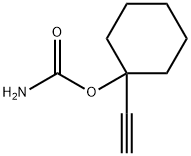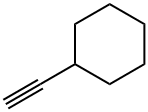ETHINAMATE
Synonym(s):1-Ethynylcyclohexanol carbamate
- CAS NO.:126-52-3
- Empirical Formula: C9H13NO2
- Molecular Weight: 167.21
- MDL number: MFCD00063343
- EINECS: 204-789-4
- SAFETY DATA SHEET (SDS)
- Update Date: 2024-12-18 14:08:52

What is ETHINAMATE?
Absorption
Rapidly absorbed following oral administration.
Toxicity
Symptoms of overdose include shortness of breath or slow or troubled breathing, slow heartbeat, severe weakness, chronic confusion, slurred speech, and staggering.
Originator
Valmid,Dista,US,1955
The Uses of ETHINAMATE
Ethinamate (E890730) is a an active central nervous system depressant used in the treatment of insomnia.
Background
Ethinamate is a short-acting sedative-hypnotic medication used to treat insomnia. Like many such similar medications, the regular use of ethinamate can result in the development of drug tolerance in a patient. Nevertheless, the medication itself is generally no longer effective after using it for greater than 7 days. Structurally, it does not resemble the barbituates, but it shares many effects with this class of drugs; the depressant effects of ethinamate are, however, generally milder than those of most barbiturates.
Indications
Used for the short-term treatment of insomnia, however, it generally has been replaced by other sedative-hypnotic agents.
Definition
ChEBI: A carbamate ester that is the 1-vinylcyclohexyl ester of carbamic acid. A short-acting sedative-hypnotic, it was formerly used to treat insomnia.
Manufacturing Process
A solution of 34 cc (0.5 mol) of liquid phosgene in 150 cc of absolute ether is reacted while cooling with a mixture of sodium chloride and ice, first with 62 grams (0.5 mol) of 1-ethinyl cyclohexanol-1 and then with 64 cc (0.5 mol) of quinoline. The precipitated quinoline chlorohydrate is filtered off and the filtrate is reacted with ammonia in ether. In this manner 45 grams of the carbamic acid ester of 1-ethinyl cyclohexanol are obtained. Yield: 53% of the theoretical yield. The ester boils at 108° to 110°C/3 mm and on recrystallization from cyclohexane, yields colorless needles melting at 94° to 96°C.
Therapeutic Function
Sedative
Pharmacokinetics
Ethinamate is used to treat insomnia (trouble in sleeping). However, it has generally been replaced by other medicines for the treatment of insomnia. If ethinamate is used regularly (for example, every day) to help produce sleep, it is usually not effective for more than 7 days. Structurally, it does not resemble the barbiturates, but it shares many effects with this class of drugs; the depressant effects of ethinamate are, however, generally milder than those of most barbiturates. Continued and inappropriate use of ethinamate can lead to tolerance and physical dependence, with withdrawal symptoms very similar to those of the barbiturates.
Safety Profile
A deadly human poison. Experimental poison by ingestion, intravenous, subcutaneous, and intraperitoneal routes. An experimental teratogen. When heated to decomposition it emits toxic fumes of NOx. See also CARBAMATES.
Metabolism
Hepatic.
Properties of ETHINAMATE
| Melting point: | 96-98° |
| Boiling point: | bp3 118-122° |
| Density | 1.1222 (rough estimate) |
| refractive index | nD21.5 1.4441 (20% in propylene glycol) |
| solubility | Chloroform (Slightly), Methanol (Slightly) |
| pka | 13.40±0.50(Predicted) |
| form | neat |
| EPA Substance Registry System | Cyclohexanol, 1-ethynyl-, carbamate (126-52-3) |
Safety information for ETHINAMATE
| Signal word | Warning |
| Pictogram(s) |
 Exclamation Mark Irritant GHS07 |
| GHS Hazard Statements |
H302:Acute toxicity,oral |
Computed Descriptors for ETHINAMATE
New Products
4-Fluorophenylacetic acid 4-Methylphenylacetic acid N-Boc-D-alaninol N-BOC-D/L-ALANINOL Tert-butyl bis(2-chloroethyl)carbamate 3-Morpholino-1-(4-nitrophenyl)-5,6-dihydropyridin- 2(1H)-one Furan-2,5-Dicarboxylic Acid Tropic acid S-2-CHLORO PROPIONIC ACID ETHYL ISOCYANOACETATE 2-Bromo-1,3-Bis(Dimethylamino)Trimethinium Hexafluorophosphate (6-METHYL-[1,3]DITHIOLO[4,5-b]QUINOXALIN-2-ONE INDAZOLE-3-CARBOXYLIC ACID 4-IODO BENZOIC ACID (2-Hydroxyphenyl)acetonitrile 4-Bromopyrazole 5,6-Dimethoxyindanone 2-(Cyanocyclohexyl)acetic acid 4-methoxy-3,5-dinitropyridine 2-aminopropyl benzoate hydrochloride 1-(4-(aminomethyl)benzyl)urea hydrochloride diethyl 2-(2-((tertbutoxycarbonyl)amino) ethyl)malonate tert-butyl 4- (ureidomethyl)benzylcarbamate Ethyl-2-chloro((4-methoxyphenyl)hydrazono)acetateRelated products of tetrahydrofuran








You may like
-
 2033-24-1 98%View Details
2033-24-1 98%View Details
2033-24-1 -
 42831-50-5 5-METHYLISOXAZOLE-4-CARBOXYLIC ACID 98%View Details
42831-50-5 5-METHYLISOXAZOLE-4-CARBOXYLIC ACID 98%View Details
42831-50-5 -
 1975-50-4 98%View Details
1975-50-4 98%View Details
1975-50-4 -
 2-HYDROXY BENZYL ALCOHOL 98%View Details
2-HYDROXY BENZYL ALCOHOL 98%View Details
90-01-7 -
 2-Chloro-1,3-Bis(Dimethylamino)Trimethinium Hexafluorophosphate 221615-75-4 98%View Details
2-Chloro-1,3-Bis(Dimethylamino)Trimethinium Hexafluorophosphate 221615-75-4 98%View Details
221615-75-4 -
 61397-56-6 CIS BROMO BENZOATE 98%View Details
61397-56-6 CIS BROMO BENZOATE 98%View Details
61397-56-6 -
 14714-50-2 (2-Hydroxyphenyl)acetonitrile 98+View Details
14714-50-2 (2-Hydroxyphenyl)acetonitrile 98+View Details
14714-50-2 -
 118753-70-1 98+View Details
118753-70-1 98+View Details
118753-70-1